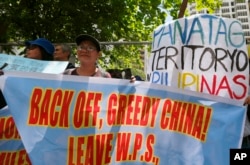Philippine President Rodrigo Duterte’s plans to deploy troops to islands in the disputed South China Sea and personally plant a flag there indicate the country has tired of China’s maritime expansion, despite friendly relations since October.
Duterte told reporters Thursday he would send troops to nine tiny features in the Spratly Island chain in the South China Sea just west of the main Philippine archipelago.
Brunei, China, Malaysia, Taiwan and Vietnam have claims in the same island chain.
His announcement Thursday also called for new or repaired facilities on the Philippines’ Spratly holdings, news outlets in Manila said.
China voiced its surprise and concern about the latest development at a regular press briefing Friday. Foreign Ministry spokeswoman Hua Chunying said Beijing is speaking with the Philippines about the planned deployment and hopes to resolve the matter soon.
Analysts say China is unlikely to respond strongly to a deployment of troops in the Spratlys.
“The Chinese government, they don’t care, because they know they can fight,” said Franklin Cattigay, commander of the coast guard in Masinloc, a Philippine city dependent on fishing in waters policed by China.
Just six months ago, Duterte had started to ease four years of Sino-Philippine hostility over maritime disputes with a visit to Beijing, which claims nearly the entire South China Sea, including much of Manila’s exclusive economic zone.
A flag-planting would “call attention that there is still a dispute in the South China Sea,” said Termsak Chalermpalanupap, a maritime security-specialized fellow with the ISEAS Yusof Ihsak Institute in Singapore.
Duterte did not say how many troops he would send to the Spratlys, where at least one islet, called Pag-asa or Thitu, already bunks soldiers and has an airstrip. Last June, the Philippine leader said he may visit Pag-asa to plant the Philippine flag on independence day.
New hot spot
Duterte’s announcement follows a disclosure that Chinese research vessels were stationed last year at a Philippine-controlled plateau under the Pacific Ocean off the country’s northeast coast.
The president told reporters in mid-March he knew about Chinese vessels at Benham Rise, a 13 million-hectare plateau rich in minerals and undersea natural gas. At least one research vessel spent about three months there.
That case is adding to calls among Filipinos, including some in government and fishermen weary of being blocked by Chinese vessels, to stand up to Beijing.
“The line would be if China does one of the following: one if they pursue an aggressive survey of the (Benham Rise) area not within the limits of the U.N. Convention on the Law of the Sea, which gave us sovereign rights,” said Ramon Casiple, executive director of the Philippine advocacy group Institute for Political and Electoral Reform.
“Second case, maybe if they (do not) acknowledge in words and in deeds the sovereign rights,” he said.
The United Nations Commission on the Limits of the Continental Shelf approved the Philippine claim to Benham Rise in 2012. China’s foreign ministry has said the U.N. Convention lets it freely navigate or pass over the rise.
“Certainly China has no legal basis for any countervailing claim either to the sovereign rights to the seabed or to the column because for the obvious reason we’re talking about a feature that’s on the opposite side of the archipelago,” said Euan Graham, international security director with the Lowy Institute for International Policy in Sydney.
Manila may offer a concession to parts of Benham Rise, which is 35 meters below the ocean surface at its highest, for resource exploration. Last year firms from Japan, already a big investor in the Philippines, and South Korea expressed interest.
Fighting back
Duterte told a news conference on March 13 he hoped to keep peace with China. He has said the Philippine armed forces lack the strength to fight China if needed.
“Let us not fight about ownership or sovereignty at this time, because things are going great for my country,” Duterte told the news conference concerning Benham Rise, as shown in a video on the local news site Philstar.com. “I cannot match the might of China.”
Beijing, with one of the world’s most powerful armed forces, is militarizing parts of the South China Sea, including islets in the Spratly chain.
China has angered the Philippines since 2012 by occupying Scarborough Shoal, a prime South China Sea fishing ground 198 kilometers west of Luzon Island. Beijing has alarmed Malaysia, Vietnam and the Philippines over the past half-decade by landfilling small islets for military use.
The 3.5 million-square-kilometer South China Sea is coveted for fisheries, shipping lanes and fossil fuel reserves.









